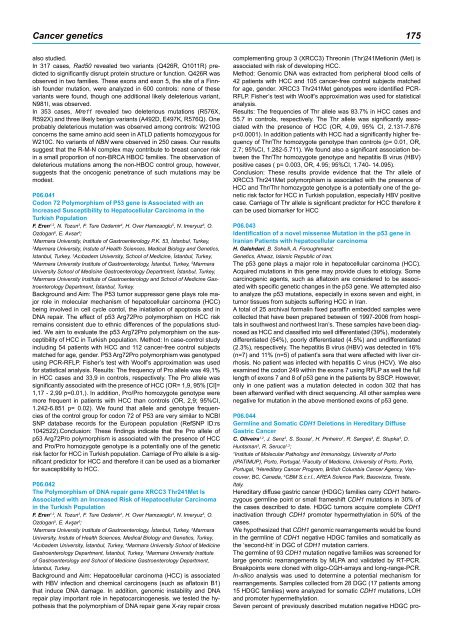2009 Vienna - European Society of Human Genetics
2009 Vienna - European Society of Human Genetics
2009 Vienna - European Society of Human Genetics
Create successful ePaper yourself
Turn your PDF publications into a flip-book with our unique Google optimized e-Paper software.
Cancer genetics<br />
also studied.<br />
In 317 cases, Rad50 revealed two variants (Q426R, Q1011R) predicted<br />
to significantly disrupt protein structure or function. Q426R was<br />
observed in two families. These exons and exon 5, the site <strong>of</strong> a Finnish<br />
founder mutation, were analyzed in 600 controls: none <strong>of</strong> these<br />
variants were found, though one additional likely deleterious variant,<br />
N981I, was observed.<br />
In 353 cases, Mre11 revealed two deleterious mutations (R576X,<br />
R592X) and three likely benign variants (A492D, E497K, R576Q). One<br />
probably deleterious mutation was observed among controls: W210G<br />
concerns the same amino acid seen in ATLD patients homozygous for<br />
W210C. No variants <strong>of</strong> NBN were observed in 250 cases. Our results<br />
suggest that the R-M-N complex may contribute to breast cancer risk<br />
in a small proportion <strong>of</strong> non-BRCA HBOC families. The observation <strong>of</strong><br />
deleterious mutations among the non-HBOC control group, however,<br />
suggests that the oncogenic penetrance <strong>of</strong> such mutations may be<br />
modest.<br />
P06.041<br />
codon 72 Polymorphism <strong>of</strong> P53 gene is Associated with an<br />
increased susceptibility to Hepatocellular carcinoma in the<br />
turkish Population<br />
F. Eren1,2 , N. Tozun3 , F. Ture Ozdemir4 , H. Over Hamzaoglu5 , N. Imeryuz6 , O.<br />
Ozdogan6 , E. Avsar6 ;<br />
1Marmara University, Institute <strong>of</strong> Gastroenterology P.K. 53, İstanbul, Turkey,<br />
2Marmara University, Instute <strong>of</strong> Health Sciences, Medical Biology and <strong>Genetics</strong>,<br />
Istanbul, Turkey, 3Acıbadem University, School <strong>of</strong> Medicine, İstanbul, Turkey,<br />
4 5 Marmara University Institute <strong>of</strong> Gastroenterology, İstanbul, Turkey, Marmara<br />
University School <strong>of</strong> Medicine Gastroenterology Department, İstanbul, Turkey,<br />
6Marmara University Institute <strong>of</strong> Gastroenterology and School <strong>of</strong> Medicine Gastroenterology<br />
Department, İstanbul, Turkey.<br />
Background and Aim: The P53 tumor suppressor gene plays role major<br />
role in molecular mechanism <strong>of</strong> hepatocellular carcinoma (HCC)<br />
being involved in cell cycle contol, the iniatiation <strong>of</strong> apoptosis and in<br />
DNA repair. The effect <strong>of</strong> p53 Arg72Pro polymorphism on HCC risk<br />
remains consistent due to ethnic differences <strong>of</strong> the populations studied.<br />
We aim to evaluate the p53 Arg72Pro polymorphism on the susceptibility<br />
<strong>of</strong> HCC in Turkish population. Method: In case-control study<br />
including 54 patients with HCC and 112 cancer-free control subjects<br />
matched for age, gender. P53 Arg72Pro polymorphism was genotyped<br />
using PCR-RFLP. Fisher’s test with Woolf’s approximation was used<br />
for statistical analysis. Results: The frequency <strong>of</strong> Pro allele was 49,1%<br />
in HCC cases and 33,9 in controls, respectively. The Pro allele was<br />
significantly associated with the presence <strong>of</strong> HCC (OR= 1,9, 95% [CI]=<br />
1,17 - 2,99 p=0.01,). In addition, Pro/Pro homozygote genotype were<br />
more frequent in patients with HCC than controls (OR, 2,9; 95%CI,<br />
1.242-6.851 p= 0.02). We found that allele and genotype frequencies<br />
<strong>of</strong> the control group for codon 72 <strong>of</strong> P53 are very similar to NCBI<br />
SNP database records for the <strong>European</strong> population (RefSNP ID:rs<br />
1042522).Conclusion: These findings indicate that the Pro allele <strong>of</strong><br />
p53 Arg72Pro polymorphism is associated with the presence <strong>of</strong> HCC<br />
and Pro/Pro homozygote genotype is a potentially one <strong>of</strong> the genetic<br />
risk factor for HCC in Turkish population. Carriage <strong>of</strong> Pro allele is a significant<br />
predictor for HCC and therefore it can be used as a biomarker<br />
for susceptibility to HCC.<br />
P06.042<br />
the Polymorphism <strong>of</strong> DNA repair gene XRcc3 thr241met is<br />
Associated with an increased Risk <strong>of</strong> Hepatocellular carcinoma<br />
in the turkish Population<br />
F. Eren 1,2 , N. Tozun 3 , F. Ture Ozdemir 1 , H. Over Hamzaoglu 4 , N. Imeryuz 5 , O.<br />
Ozdogan 5 , E. Avşar 5 ;<br />
1 Marmara University Institute <strong>of</strong> Gastroenterology, İstanbul, Turkey, 2 Marmara<br />
University, Instute <strong>of</strong> Health Sciences, Medical Biology and <strong>Genetics</strong>, Turkey,<br />
3 Acıbadem University, İstanbul, Turkey, 4 Marmara University School <strong>of</strong> Medicine<br />
Gastroenterology Department, İstanbul, Turkey, 5 Marmara University Institute<br />
<strong>of</strong> Gastroenterology and School <strong>of</strong> Medicine Gastroenterology Department,<br />
İstanbul, Turkey.<br />
Background and Aim: Hepatocellular carcinoma (HCC) is associated<br />
with HBV infection and chemical carcinogens (such as aflatoxin B1)<br />
that induce DNA damage. In addition, genomic instability and DNA<br />
repair play important role in hepatocarcinogenesis. we tested the hypothesis<br />
that the polymorphism <strong>of</strong> DNA repair gene X-ray repair cross<br />
complementing group 3 (XRCC3) Threonin (Thr)241Metionin (Met) is<br />
associated with risk <strong>of</strong> developing HCC.<br />
Method: Genomic DNA was extracted from peripheral blood cells <strong>of</strong><br />
42 patients with HCC and 105 cancer-free control subjects matched<br />
for age, gender. XRCC3 Thr241Met genotypes were identified PCR-<br />
RFLP. Fisher’s test with Woolf’s approximation was used for statistical<br />
analysis.<br />
Results: The frequencies <strong>of</strong> Thr allele was 83.7% in HCC cases and<br />
55.7 in controls, respectively. The Thr allele was significantly associated<br />
with the presence <strong>of</strong> HCC (OR, 4,09, 95% CI, 2.131-7.876<br />
p

















